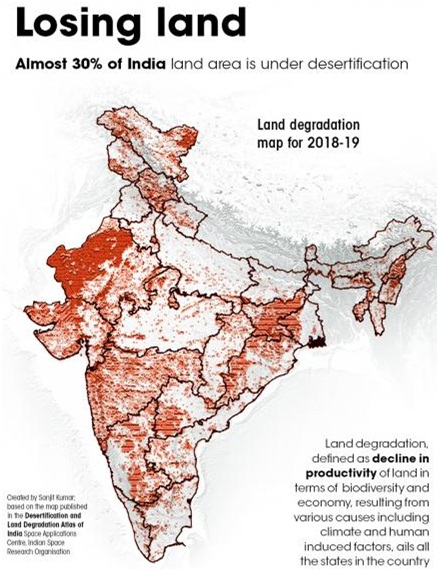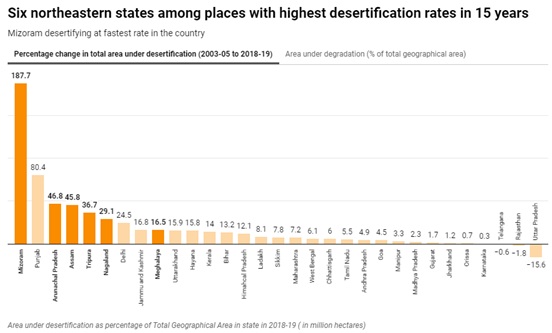

Context
The Indian Space Research Organization (ISRO) released the Desertification and Land Degradation Atlas of India, which shows a worrisome picture of land degradation in India’s north-east.
Background
- With close to 30 per cent of its geographical area already affected, land degradation is definitely among India’s most pressing environmental problems.
- In the last 15 years, almost all Indian states have recorded an increase in degraded land, with the most rapid increase being noted in the biodiversity-rich northeastern states.
- The scientists at ISRO compared the data collected between 2003 and 2005 with that gathered in 2018-19.
- Currently, 97.85 million hectares (mha) of land has already been degraded.
- Of this, 3.32 mha has been added in the 15 years between 2003-05 and 2018-19.
- Silver lining: Rajasthan, the most degraded state, along with Uttar Pradesh and Telangana, have seen a reduction in their degraded land in the last 15 years.
- Rajasthan, which accounts for almost 22 per cent of the degraded land in the country, reclaimed almost 388,000 ha, an area roughly 2.6 times the size of Delhi.
- Uttar Pradesh (285,665 ha) and Telangana (19,974 ha) together reclaimed degraded land twice the size of Delhi during the period.
|
Forestland degradation
|

Key-findings of the Report-cum-Atlas
- Six states in northeastern India were among the top 10 places in the country with the highest rates of desertification between 2003 and 2018, according to a recent report.
- These are Mizoram, Arunachal Pradesh, Assam, Tripura, Nagaland and Meghalaya.
- Punjab, Delhi, Jammu and Kashmir and Uttarakhand in northern India also witnessed some of the highest rates of desertification.

The most vulnerable areas
Mizoram desertifying fastest
- Mizoram has been desertifying at the fastest rate in the country.
- Land degradation and desertification increased 2.8 times in the state in the 15-year period studied.
- A total of 0.18 million hectares (mha) underwent degradation/desertification in those years — an increase of over 188 per cent.
Rapid degradation in Arunachal, Nagaland
- Arunachal Pradesh: In Arunachal Pradesh, 2.4 per cent of the area or 0.2 mha underwent degradation / desertification in 2018-19. Between 2003-05 and 2018-19, degradation / desertication increased 46 per cent in the state.
- Nagaland: Over half the 200,683 ha geographical area of the state was found to be degraded / desertified in 2018-19, whereas, the share of degraded land was 38.74 per cent in 2003-05.
|
Understanding Land degradation & Desertification
- Land degradation is defined as decline in productivity of land in terms of biodiversity and economy, resulting from various causes, including climate and human dominance, leading to loss of ecosystem.
- Desertification is a type of land degradation in which a relatively dry region becomes increasingly arid, typically losing its water bodies as well as vegetation and wildlife.
|
As a signatory to the United Nations Convention to Combat Desertification, India is committed to reducing its land degradation and desertification. In fact, India’s goal is to achieve land degradation neutral status by 2030 whereby increases in land degradation would be offset by gains in land reclamation. |
Main causes of land degradation and desertification
- Deforestation and loss of green cover
- Human settlements and water erosion
- Water logging
- Vegetation degradation (96 per cent) is the major reason for forest degradation.
- Vegetation degradation is referred to as reduction in the biomass and / or decline in the vegetative ground cover, as a result of deforestation and / or overgrazing.
- A lot of erosion happens because the top soil remains exposed and got washed away easily with rains.
- The US, after a major dust storm event in the 1930s, brought a legislation that says the top soil of any land should not remain exposed.
|
It is surprising that 66 per cent of the farmland in the country remains rainfed, according to the Pocket Book of Agricultural Statistics 2020, released by the Union Agriculture and Farmers’ Welfare in May 2021. |
Why land degradation is a concern?
- Carbon: Land degradation reduces the soil’s ability to absorb carbon.
- Worsened climate change: Land degradation and climate changefuel each other.
- Threat to food security: Degraded land in the country is either rainfed farmland, responsible for the food security of the country, or forest land that offers the best defence against climate change.
- Economic loss: Lost productivity can weigh heavily on the economy.
Way forward
Land degradation can exacerbate climate change and threaten agricultural productivity, water quality, biodiversity, sustainable development, and the living conditions of humans and wildlife, among other effects. Reclaiming degraded lands will require a strict land-use policy and better watershed management initiatives.


